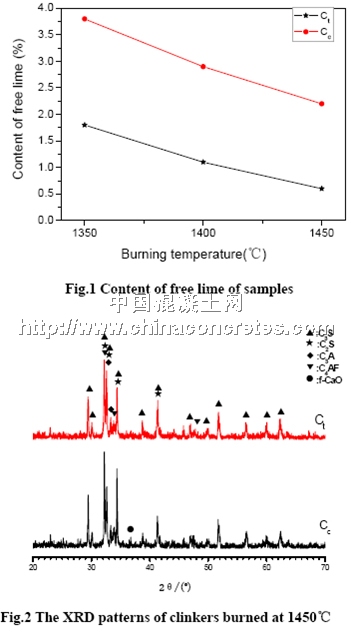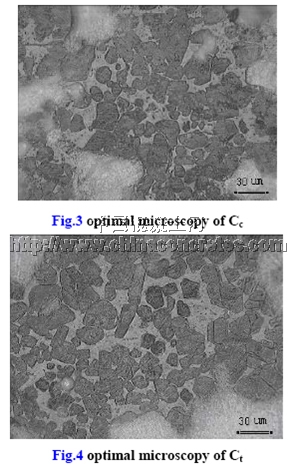摘要:铅锌尾矿的主要化学组成是CaO,SiO2,Al2O3,和Fe2O3,这些组分的存在使铅锌尾矿有可能成为生产水泥的原料。本文研究了掺加和不掺加铅锌尾矿的原料的易烧性以及所得水泥熟料的性能。配制了两种不同的原料并分别在1350℃,1400℃,和1450℃下进行煅烧,熟料所测性能主要有游离钙含量,X射线粉末衍射分析,岩相分析,以及强度。结果表明掺加铅锌尾矿的配方在1450℃下煅烧游离钙含量低于1.0%,阿利特相形成较好。测定了由这些熟料掺加4%的石膏所配水泥的性能。结果表明铅锌尾矿可以用来生产硅酸盐水泥熟料,不会产生不良影响。
关键词:铅锌尾矿 水泥熟料 游离氧化钙 易烧性
中图分类号:TQ172.1
0 Introduction
Pb/Zn (Lead/Zinc) mine tailing is the by-product created in the process of floatation of Pb/Zn mine. Pb/Zn mine tailing is complex because the chemical and mineralogical composition varies widely depending on the source of original ore and the method of processing. However the main chemical composites of them are four kinds, namely, CaO, SiO2, Al2O3, and Fe2O3. There also exist small quantities of minor/trace elements such as Zn, Cu, Pb, etc. Now the main disposal means of the tailing is to pipe them into reservoir, however this not only wastes resources but also causes a number of environmental problems. So it is important to develop efficient methods to utilize the tailing.
Many researchers have studied the influence of these minor/trace elements on the sintering and strength of cement clinker. It was found that the elements of Pb[1] and Cu[2] have positive influence on the synthesis of clinker. Some of them found that only when the dosage is much higher than in ordinary Portland cement, Zn has positive influence on the structure and reactivity of the C3S[3]; however some others discovered that Zn could have mineralization effect for the sintering of clinker[1]. And some others considered that all of them can impel the appearance of liquid phase at lower temperature, accelerating the formation of C3S, improving the burnability of the raw meal, raising the strength of clinker, and reducing the consumption of fuel[1~8]. Now many cement plants in China begin to use Pb/Zn tailing as mineraliser in cement production, but the dosage is very low. It is rarely reported about the application of Pb/Zn mine tailing as stuff in the burning of high-strength Portland clinker.
This paper investigated the burnability and properties of high-strength Portland clinkers, which were produced from Lead/Zinc (Pb/Zn) mine tailing, shale, limestone, and ironstone in laboratory. Then the properties of the resulting clinker were tested.
1 Experiment Methods
1.1 Raw Materials
In the experiments, clay, lead/zinc mine tailing, shale, ironstone, and limestone were used as raw materials. The chemical compositions of these raw materials were presented in Table 1.

1.2 Sample Preparation and Sintering
In the experiment, each of the raw materials was ground till that more than 90% of them was finer than 80μm, and then weighed accurately in proportion and mixed together. The raw meals were homogenized and finely ground (<80μm). After adding 20% pure water, the raw meals were extruded into cylinders as Ø13 ×13mm3, which weighed 3.6±0.1g. These specimens were dried at 105 for 2 hours in an oven, and then were put into ℃an electrically heated furnace. It was followed a rule: cured at 900 for 30 minutes, which had been ℃raised to 900 before, Then heated to ℃1350, ℃1400, or 1450 ℃℃respectively and cured for 1 hour. Finally the samples were taken out and cooled dramatically to room temperature for the prevention of crystal phase transformation of C2S.
1.3 Methods for investigation
Parts of the clinkers were ground to finer than 80μm, and then were analyzed for the content of free CaO by glycerol ethanol method.
The mineral composition was determined by X-ray powder diffraction (XRD).
For the phase analysis by optical microscopy, the clinker was crushed (<5mm) and then fractions were selected to be embedded in sulfur within a mold. At last the samples were polished by alumina powder. After mixed with 4% gypsum, the clinkers were ground into cement, the specific surface area of which was about 350 m2·kg-1. The physical and mechanical properties of cement produced from the industrial clinkers were tested, according to the Chinese standard of GB 175-1999.
2 Results and Discussion
2.1 Proportioning Control
The amounts of each component in raw meals were calculated on the basis of three moduli: lime saturation factor (KH), silica modulus (SM), and iron modulus (IM). The related equations were given in Eqs. (1), (2), and (3):
KH=(CaO-1.65Al2O3-0.35Fe2O3)/2.8SiO2 (1)
SM=SiO2/(Al2O3+Fe2O3) (2)
IM=Al2O3/Fe2O3 (3)
In experiments, two raw meals with clay (signed as Cc) or with Pb/Zn mine tailing (signed as Ct) respectively were prepared to compare the difference of burnability of them. The moduli of clinkers were designed as follows: SM was fixed as 2.47; KH was selected as 0.98; and IM was 1.78.
2.2 Contents of Free Lime
The content of free lime in clinkers can be seen as an indicator of the degree of burning, the increase of free lime in clinker means the debasement of burnability. On the contrary, the decrease of free lime means the improvement of burnability. The contentsof free lime of the clinkers were presented in Fig.1. Fig.1 shows that with the rise of sintering temperature, the contents of free lime are decreasing, which means that higher sintering temperature can accelerate the synthesis of clinker minerals. When the burning temperature is up to 1450, the ℃contents of free CaO of the clinker with Pb/Zn mine tailing is lower than 1.0%, but that of the clinker with clay is higher than 2.0%. It may be considered as the mineraliser effect of Pb/Zn mine tailing.

2.3 XRD Analysis
The XRD patterns of Cc and Ct burned at 1450℃ were listed in Fig.2. It can be seen that the main compounds were C3S (2θ=29.30, 32.12, 32.46, 34.28, 51.75, 56.25, 62.12º) , C2S (2θ=32.01, 32.15, 32.57, 34.34, 41.03°), C3A (2θ=32.91, 33.01, 33.23, 47.3, 59.53°), C4AF (2θ=32.29, 34.06, 44.60, 47.31°), and free CaO (2θ=37.35, 53.85°). XRD analysis shows that the formed compounds of the two kind clinkers are similar. There is no apparent difference between the two XRD patterns, indicating that the use of Pb/Zn tailing in the clinker burning does not bring any undesirable change.
2.4 Optimal Microscopy Analysis
Clinker microstructure was examined by optimal microscopy in polished sections. The photos of specimens of Cc and Ct are presented in Fig.3 and Fig.4 respectively. It seemed that the use of Pb/Zn mine tailing did not affect the formation of the main mineralogical phase. It can be seen that the alite crystals in sample Ct appear to be well formed, and the belite phase appears as fine round crystals, probably due to the higher content of trace elements. At the same time the liquid phase appears as fine crystal and distribute evenly. It is saying that the clinkerization of Ct is as good as Cc.

2.5 Properties of cement
The clinkers were coground with 4% gypsum to about 320 m2·kg-1. The physical and mechanical properties of these cements were tested in accordance with the Chinese standard of GB 175-1999, and the results were listed in Table 2.

The results show that all the tested performances of A and B cements can meet the Chinese standard of Portland cement. As expected the initial and final setting time of cement used Pb/Zn tailing are prolonged, which is due to the effect of Zn element.
3 Conclusions
Based on the test results obtained in this study, the following conclusions can be drawn:
It is feasible to prepare high strength Portland clinker using raw mixes containing Pb/Zn mine tailing. This makes it possible to use these tailings substitute clay, and this will contribute to environmental advantage.
The use of Pb/Zn mine tailing as an alternative component of clay was promising. The strength was improved; although prolonged, the setting time can meet the standard.
References
1 S. Cui, M. Lan, J. Zhang, et al. Effect and incorporation mechanism of heavy metal elements in hazardous industrial wastes during clinker formation[J]. J. Chin. Ceram. Soc, 2004, 32(10): 1264
2 G. Kakali, G. Parissakis, D. Bouras. A study on the burnability and the phase formation of PC clinker containing Cu oxide[J]. Cem. Concr. Res, 1996, 26(12): 1473.
3 D. Stephan, H. Maleki, D. Knofel, et al. Influence of Cr, Ni, and Zn on the properties of pure clinker phases: Part I. C3S[J]. Cem. Concr. Res, 1999, 29(4): 545
4 G. Xu, W. Huang, Z. Lu, et al. The effect of ZnO on burning of Portland cement clinker in rapid heating-up burning[A]. 9th ICCC[C]. India, New Delhi, 1992: 372
5 S. Ma, X. Shen, Y. Huang, et al. Effect of zno on the formation and coexistence temperature range of alite and calcium sulphoaluminate[J]. J. Chin. Ceram. Soc, 2006, 34(11): 1392
6 G. Kakali, G. Parissakis. Investigation of the effect of Zn oxide on the formation of Portland cement clinker[J]. Cem. Concr. Res. 1995, 25(1): 79
7 M. Murat, F. Sorrentino. Effect of large additions of Cd, Pb, Cr, Zn, to cement raw meal on the composition and the properties of the clinker and cement[J]. Cem. Concr. Res. 1996, 26(3): 377
8 K. Kolovos, S. Tsivilis, G. Kakali. The effect of foreign ions on the reactivity of the CaO-SiO2-Al2O3-Fe2O3 system part Ⅱ: Cations[J]. Cem. Concr. Res, 2002, 32(3): 463

















